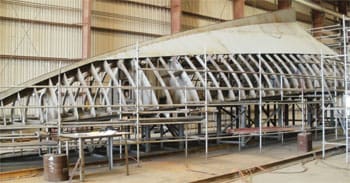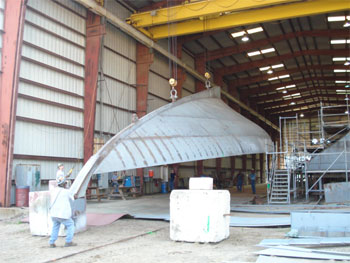Replicas of classic sailing vessels are typically the work of specialty wooden boatbuilders employing traditional techniques and adhering as closely as possible to the original plans and the designer’s vision. But consider this — a commercial shipyard noted for building sophisticated working vessels including ferries, tugs, and offshore supply ships has embarked on building a replica of the classic 141-foot Gloucester fishing schooner, Columbia.
Eastern Shipbuilding of Panama City, Fla., is now in the process of building not one, but two replicas of famed-designer Starling Burgess’ schooner Columbia, in steel.
The idea for the project came from Eastern Shipbuilding’s president Brian D’Isernia who himself was a commercial fisherman before turning his talents to shipbuilding. According to Columbia’s project manager, Jacob A. Stevens, D’Isernia found the lines at the Essex Shipbuilding Museum in Massachusetts and endeavored to build it for himself. Now after two and a half years of building, the project is proceeding so well that D’Isernia has laid the keel for a second Columbia.
|
Columbia’s steel hull taking shape. |
Columbia was originally designed by Burgess who was a much sought-after naval architect, inventor, and aviation pioneer. The boat was built in 1923 by the yard of Arthur Dana Story in Essex, Mass., who built many of the famous Gloucester schooners including the Frank Paine-designed Gertrude L. Thebaud.
Many consider Columbia as the final development of the Gloucester fishing schooner. The boat was renowned for its seaworthiness and speed and raced in many international competitions including a race against the Canadian Bluenose in Halifax, Nova Scotia in 1923. The two were so close in the first race that they collided. Columbia was fast but Bluenose proved more “able” and won the contest.
Tragedy struck in August 1927 when two gales swept down on the schooner and Columbia was lost with all hands off Sable Island, often called “the graveyard of the Atlantic.”
But to build a new Columbia, D’Isernia needed more than just a talented shipyard crew of welders and engineers — he needed a project manager who was as committed and passionate about building a new Columbia as he was. D’Isernia hired Stevens as project manager. Stevens was an experienced shipbuilder having put in his time at such venerable yards as Bath Iron Works, Washburn & Doughty, and Blount Marine. He also came from a long line of Maine shipbuilders. Stevens’ grandfather Jacob Arthur Stevens started Goudy & Stevens in East Boothbay in 1919 with Wallace Goudy. In 1967 Goudy & Stevens built a replica of the schooner yacht America. Jake and his older brother Joel ran the yard until it was sold in 1994.
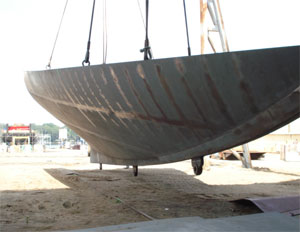 |
|
The schooner’s hull is moved back into the shed for construction of the interior and deck. |
But building a replica of the 141-foot Columbia out of steel is a unique challenge as Burgess’ lines are complex. They were adapted for steel construction by Gilbert Associates, naval architects in Boston. The schooner has a graceful sheer, a short keel, and is straight on the bottom from the sternpost running forward to a point just beyond midships. There is a strong, almost straight fore rake that fairs into a long pointed stem. The schooner has a long counter that is partly immersed and ends in a sharply raking heart-shaped transom. The bow entrance is long, slightly convex and sharp. The run of the hull has long straight buttocks and the bilge is high with a nice tumblehome in the topsides.
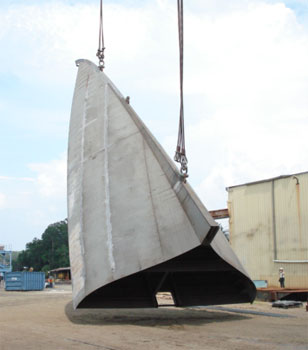 |
|
The bow section of Columbia is flipped over. |
Stevens said that the biggest challenge in building the steel yacht was fairing the hull. He credits his mentor at Bath Iron Works for giving him the skills to fair a steel hull and have it nearly indistinguishable from wood.
Columbia is built to the exact offsets of the original. The only major change was the deckhouse which was extended for accommodations below and the break in the deck was moved forward 38 inches to allow for a modern watertight bulkhead. There are even two insulated fish holds in keeping with the original vessel’s purpose.
The schooner is 141 feet overall, 110 feet at the waterline with a beam of 25.5 feet and a draft of 15 feet 7 inches and will spread more than 10,000 square feet of sail.
The masts and booms are laminated select Douglas fir and the topmast is Sitka spruce. The spars were all built by Covey Island Boatworks of Lunenburg, Nova Scotia. Michele Stevens Sailloft, also of Lunenburg, is building the sails. Coincidently both companies have played a major role in the recent restoration of Bluenose II.
Dorian Steele, son of Covey Island Boatworks founder John Steele is responsible for the rigging and for building two dories for the boat.
Columbia’s steel hull plating is five-sixteenths of an inch and A-36 certified with a quarter-inch deck and bulwark plate. All the rigging is traditional. The standing rigging is galvanized, parceled and served with lignum vitae deadeyes.
The decks are swathed in teak and mounted on that teak is modern deck equipment including Harken sail winches and a Ridderinkhof anchor windlass.
Below deck, the joinery is all mahogany with teak and maple interior flooring. The interior accommodations are as close as possible to the original plans.
Power is provided by a single Caterpiller C18, 580-hp marine diesel mated to a Hundersted gearbox with controllable pitch propeller. Fuel capacity is roughly 5,000 gallons. There is also a True Power 16-inch bow thruster.
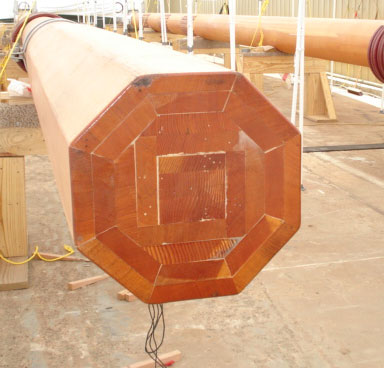 |
|
Covey Island Boatworks built the masts which are 20 inches in diameter at the deck. |
Auxiliary power comes from two Northern Lights 65-kW generators. For comfort below there is a 20-ton air conditioning system. Other conveniences include two icemakers, and two Cathelco 900 GPD watermakers.
Stevens said that it is unclear what D’Isernia has planned for the two schooners, the first of which will launch in late fall. But with accommodations for 22, D’Isernia’s plans must be big.

